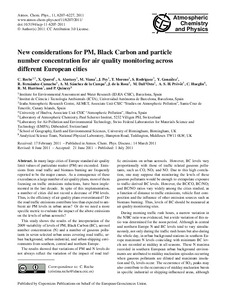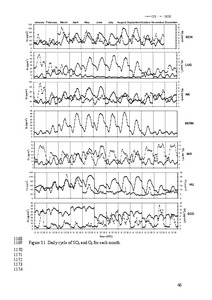Por favor, use este identificador para citar o enlazar este ítem:
http://hdl.handle.net/20.500.11765/417
New considerations for PM, Black Carbon and particle number concentration for air quality monitoring across different European cities
| Título : | New considerations for PM, Black Carbon and particle number concentration for air quality monitoring across different European cities |
| Autor : | Reche, Cristina; Querol, Xavier; Alastuey, Andrés; Viana, Mar; Pey, Jorge; Moreno Pérez, Teresa; Rodríguez González, Sergio



|
| Palabras clave : | Particulate matter; Air quality monitoring; Urban aerosols; Partículas de polvo; Contaminantes atmosféricos; Calidad del aire |
| Fecha de publicación : | 2011 |
| Editor: | European Geosciences Union |
| Citación : | Atmospheric Chemistry and Physics. 2011, 11(13), p. 6207-6227 |
| Versión del editor: | http://dx.doi.org/10.5194/acp-11-6207-2011 |
| Resumen : | In many large cities of Europe standard air quality limit values of particulate matter (PM) are exceeded. Emissions from road traffic and biomass burning are frequently reported to be the major causes. As a consequence of these exceedances a large number of air quality plans, most of them focusing on traffic emissions reductions, have been implemented in the last decade. In spite of this implementation, a number of cities did not record a decrease of PM levels. Thus, is the efficiency of air quality plans overestimated? Do the road traffic emissions contribute less than expected to ambient air PM levels in urban areas? Or do we need a more specific metric to evaluate the impact of the above emissions on the levels of urban aerosols? This study shows the results of the interpretation of the 2009 variability of levels of PM, Black Carbon (BC), aerosol number concentration (N) and a number of gaseous pollutants in seven selected urban areas covering road traffic, urban background, urban-industrial, and urban-shipping environments from southern, central and northern Europe. The results showed that variations of PM and N levels do not always reflect the variation of the impact of road traffic emissions on urban aerosols. However, BC levels vary proportionally with those of traffic related gaseous pollutants, such as CO, NO2 and NO. Due to this high correlation, one may suppose that monitoring the levels of these gaseous pollutants would be enough to extrapolate exposure to traffic-derived BC levels. However, the BC/CO, BC/NO2 and BC/NO ratios vary widely among the cities studied, as a function of distance to traffic emissions, vehicle fleet composition and the influence of other emission sources such as biomass burning. Thus, levels of BC should be measured at air quality monitoring sites. |
| Patrocinador: | This work was funded by the Spanish Ministry of Science and Innovation (VAMOS CGL2010-19464/CLI; DAURE CGL2007-30502-E/CLI, GRACCIE- CSD2007-00067), Department of Inovation, Science and Enterprise of the Andalusian Autonomous Government (AER-REG-P07-RNM-03125), the Ministry of the Environment and Rural and Marine Affairs, and the 7th FP from the EC project SAPUSS (Marie Curie intra-European Fellowship). |
| URI : | http://hdl.handle.net/20.500.11765/417 |
| ISSN : | 1680-7324 |
| Colecciones: | Artículos científicos 2010-2014 |
Ficheros en este ítem:
| Fichero | Descripción | Tamaño | Formato | ||
|---|---|---|---|---|---|
| acp-11-6207-2011.pdf | Artículo principal | 1,34 MB | Adobe PDF |  Visualizar/Abrir | |
| acp-11-6207-2011-supp... | Suplemento | 905,14 kB | Adobe PDF |  Visualizar/Abrir |
Este ítem está sujeto a una licencia Creative Commons Licencia Creative Commons






